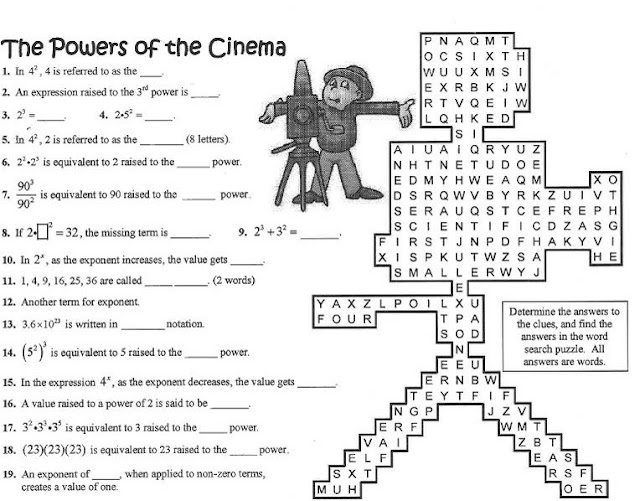So back to square one.
I'm a big fan of develop the knowledge, don't memorize rules. That way you can recreate something you may have forgotten the details for as long as you can remember the basics and develop knowledge. My high school years (in the 70s) were spent memorizing formulas and being discouraged from asking why. Very frustrating! So as a high school mathematics teacher I feel it's important to develop those whys.
This blog post is on a discussion day that I have with students in reviewing some properties of mathematics and reminding students of the awesome power of ONE! (who would think ONE would be such a powerful number!).
After the unit test from the previous unit - I jumpstart thinking with this exponents vocabulary puzzle sheet. They complete that for homework.

Then I have students do this worksheet as a warm up - all problems they should be able to do from their previous experience with exponents.
So now we are ready for our discussion class. After going over the warm up I refer to the following (written on the board):
·
1) Definition of Exponentiation
· 2) Commutative Property
· 3) Associative Property
·
4) Identity Property of Multiplication
·
5) What's behind the process of simplifying fractions (or why "cancel" is a dirty word)
We talk about what each of these mean. Here's a basic "script" of how our discussions go (I typed it all up one year to have a hard copy). I don't just talk through all these things, I ask lots of leading questions and ask students to give me examples. They should know all this material, they just need a kick start to remember.
1) Definition of Exponentiation
The exponent of a number says
how many times to use the number in a multiplication.
In 82 the
"2" says to use 8 twice in a multiplication,
so 82 = 8 × 8 = 64
so 82 = 8 × 8 = 64
Some more examples:
Example:
53 = 5 × 5 × 5 = 125
- In words: 53 could be called "5 to the
third power", "5 to the power 3" or simply "5
cubed"
Example:
x4 = x · x · x · x
- In words: 24 could be called "2 to the
fourth power" or "2 to the power 4" or simply "2 to
the 4th"
So, in general:
an
tells you to multiply a by itself,
so there are n of those a's:
|
||
2) Commutative Property
The word "commutative" comes
from "commute" or "move around", so the Commutative
Property is the one that refers to moving stuff around. For addition, the rule
is "a + b = b + a"; in numbers, this means 2 + 3 = 3 + 2. For multiplication, the rule is
"ab = ba"; in
numbers, this means 2×3 = 3×2.
3) Associative
Property
The word "associative" comes from
"associate" or "group";the Associative Property is the rule
that refers to grouping. For addition, the rule is "a + (b
+ c) = (a + b) + c"; in numbers, this means 2 +
(3 + 4) = (2 + 3) + 4. For
multiplication, the rule is "a(bc) = (ab)c"; in numbers, this means 2(3×4) = (2×3)4.
4) Identity Property of
Multiplication
The identity property of
multiplication, also called the multiplication property of one says that the
value of a number does not change when that number is multiplied by 1.
Copyright
5)
What’s behind the
process of simplifying fractions…(and why you can’t “cancel” when it’s
addition)
What allows you to simplify fractions?
A somewhat extreme meme to emphasize the horror of this type of mistake.....
http://mathcurmudgeon.blogspot.com/2014/01/do-this-and-bunny-dies.html
And I wrap things up by having students do this worksheet for homework.
|





I love the Cinema worksheet! Thanks!
ReplyDelete